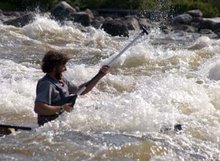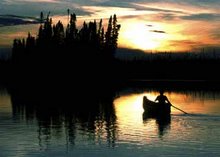
Contact- Steve King
email steveking8@hotmail.com
________________________________________________________________________
2007 Rupert River Film Expedition
______________________________________________________________________________________
Summary
•The Rupert River, in Northern Quebec. is one of the last untouched rivers of its size in the world. It has been described by many as the most beatiful river in all of Canada. The Cree Indians depend on the Rupert to sustain the last coherent hunting culture on the continent.
•The Rupert contains 65 world-class sets of rapids, six of which have never been run. It flows through pristine wilderness for 380 miles.
•Hydro-Quebec, the giant government-owned energy corporation, has received permission to include the Rupert into the largest complex of dams and reservoirs in the world.
•81% of the indigenous Cree affected by the diversion project voted not in favor of the project in December 2006. Quebec authorities are permitting construction to begin despite this fact.
•A group of professional kayakers are raising money for an expedition down the Rupert.
•Our cast/crew includes kayaking superstars, local Cree guides, expert canoists, fly fishermen, a marine biologist, a hydrogeologist, plus cinematography and support crew.
• Our purpose is to capture the majesty of the mighty Rupert on film, and to document the fight of the Crees to save their way of life. The expedition will draw much needed attention to this issue. The film will spread the news even further and make a call to action to save the Rupert River.
_____________________________________________________________________________________
Proposal
Eric Cheezo is a 44-year old Cree who was born along the banks of the Rupert. Like his father and grandfathers before him, he makes his living from the Rupert River. Soon, he may have to abandon his home, livelihood, and the graves of his ancestors in order to find a new way to feed his family.
Proponents of the project promise the diversion will create jobs, boost the regions economy, and provide more power to sell to the United States.
Oponents believe the jobs and economic boost will be temporary, while the permanent loss of the Rupert will destroy many lives and remove forever one of the great remaining natural wonders of the continent, indeed the world.
Hydro-Quebec, the company proposing the project, has never explored alternative forms of power to massive dams. The Grand Chief of the Cree has pursued the development of wind farms on Cree land as a more reasonable solution to the energy crisis.
The Rupert harbors extensive fisheries and serves as a major wilderness corridor for 300 species of migratory birds and 44 species of mammals. The water is in a pristine state, and can be drunk without filtering. For whitewater enthusiasts, the Rupert is an ideal playground, offering multiple month-long wilderness trip itineraries that are unrivaled anywhere in scenery and challenge. Among the many rapids, six have never been run. The average annual flow exceeds 100,000 cubic feet per second.
Your contribution will help the dual cause of giving the Cree people a voice and defending an amazing natural resource.
A Circumspective Look at the Film
Flashes of a kayaker emerge from within a thundering mass of whitewater. Somehow she makes it through the rapids into a safe eddy the size of a football field. The frame pulls back, zooming out until the paddler is a tiny dot disappearing on the horizon of the giant river. Cut away to a Quebec courtroom in Montreal. A Cree elder explains to a judge how the destruction of the Rupert will end the way of life his people have practised for over five thousand years.
Parallel editing will be used to tell the story of the Rupert while documenting its rapids in riveting whitewater scenes. We will use cinema verite′ techniques, filming real life as it happens with people interacting rather than being directly interviewed. The kayaking and canoeing will be filmed in the exciting idiom of modern paddling films, informative sections will use a documentary style combined with animations to present the story in an inviting, entertaining, and dynamic way while also informing viewers as to what they can do to lessen their power consumption and help save the Rupert from destruction.
Post-Production and Marketing
This film will move beyond the paddling film format, and destroy the stereotype of a dour documentary. Our intention is to give the film legs to carry it past the usual markets for these genres as well.
Post-production will be handled at the studios of Interloper Films, a well-established production company in Los Angeles. We plan to use a producers representative such as Ostrow and Company, also in L.A., to distribute the film, track sales, ensure it is seen by as many as possible, and maximize revenue potential for the preservation of the Rupert River.
Our film will play a pivotal role in the movement being lead by the new Grand Chief of the Cree Nation, Matthew Mukash, who is offering to develop wind power on Cree land rather than sacrifice the Rupert.
______________________________________________________________________________________












